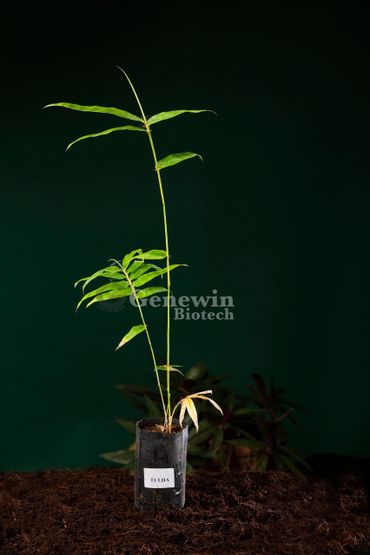BAMBUSA TULDA TISSUE CULTURE BAMBOO PLANT

Local Name
- Jati (Assam, Arunachal Pradesh, Nagaland, West Bengal)
- Wati, Owati (Meghalaya)
- Mirtinga (Tripura)
- Rawthing (Mizoram)
- Paoshiding (Sikkim)
- Deobans (Behar)
- Longmeii (Nagaland)
- Koraincho bans (Sikkim)
Uses and Applications
Conventional Applications:
• Handicrafts and basketry
• Whole culms utilized in construction
• Edible shoots
• Incense sticks
• Furniture, mats, and baskets
• Fishing rods and flutes
Commercial Applications:
• Laminated bamboo products
• Strand woven boards
• Paper pulp production
Future Prospects:
• Bioenergy and biorefinery applications
• Opportunities for carbon trading
Characteristics
- Evergreen, clumping bamboo
- Short-necked pachymorph rhizomes
- Erect culms with drooping tops
- Zig-zag pattern at lower nodes
- Culms height: up to 30 meters
- Culms diameter: up to 10 cm
- Wall thickness: 7–15 cm (varies by location)
- Internode length: 30–60 cm
Distribution
Native Range:
• Extends from Southeast Asia to China (Yunnan) and the Himalayas.
• Indian Subcontinent: Assam, Bangladesh, East Himalaya, Nepal, West Himalaya, and India.
• China: South-Central China and Tibet.
• Indo-China: Laos, Myanmar, Thailand, and Vietnam.
Cultivation Conditions
Types of Plantations:
• Commonly grown in block plantations and agroforestry systems.
Spacing:
• Typically planted with spacing of 5x5 meters or 4x4 meters.
Time to Maturity:
• Reaches maturity in 3 to 4 years.
Climatic and Soil Requirements
Climate:
• B. tulda thrives in regions with temperatures ranging from 4°C to 34°C.
• Requires annual rainfall between 1246 mm and 1400 mm, and can flourish in areas receiving up to 4000–6500 mm of precipitation.
• Grows optimally at elevations between 600 and 1500 meters.
Soil:
• Prefers fine-textured, moist alluvial soils, particularly in regions with substantial rainfall such as semi-evergreen forests.
• Also favors flat alluvial deposits for optimal growth.
Advantages of Tissue Culture Plants
- True to the type
- High market value & High yield and quality
- High biomass yielding plant
- Energy can be generated
- Throughout the year plantation possible
- Disease free Plants.
- Genetically pure and identical to mother plant.
- Uniform and high yield.
- Mass production at less time and at less cost.
- Season independent.
Photo Gallery





Copyright © 2025 Genewin Biotech - All Rights Reserved.
- About Us
- News & Resources
- Bambusa Nutans - Bamboo
- Bambusa Tulda - Bamboo
- Dendrocalamus Asper
- Dendrocalamus Brandisii
- Dendrocalamus Stocksii
- Thyrsostachys Oliveri
- G9 Grand Naine Banana
- Red Banana Plant
- Yelakki Banana Plant
- Ginger Varadha
- Black Turmeric plant
- Spider Plant
- Money Plant
- Social Media Updates
- Careers
- F.A.Q
- Privacy Policy
This website uses cookies.
We use cookies to analyze website traffic and optimize your website experience. By accepting our use of cookies, your data will be aggregated with all other user data.

